Auctions
5 Fascinating Backstories Behind the Week’s Auction Highlights, From Banksy’s Graffitied Church Window to Paula Rego’s Human Ostriches
It's going to be a very busy week in London.
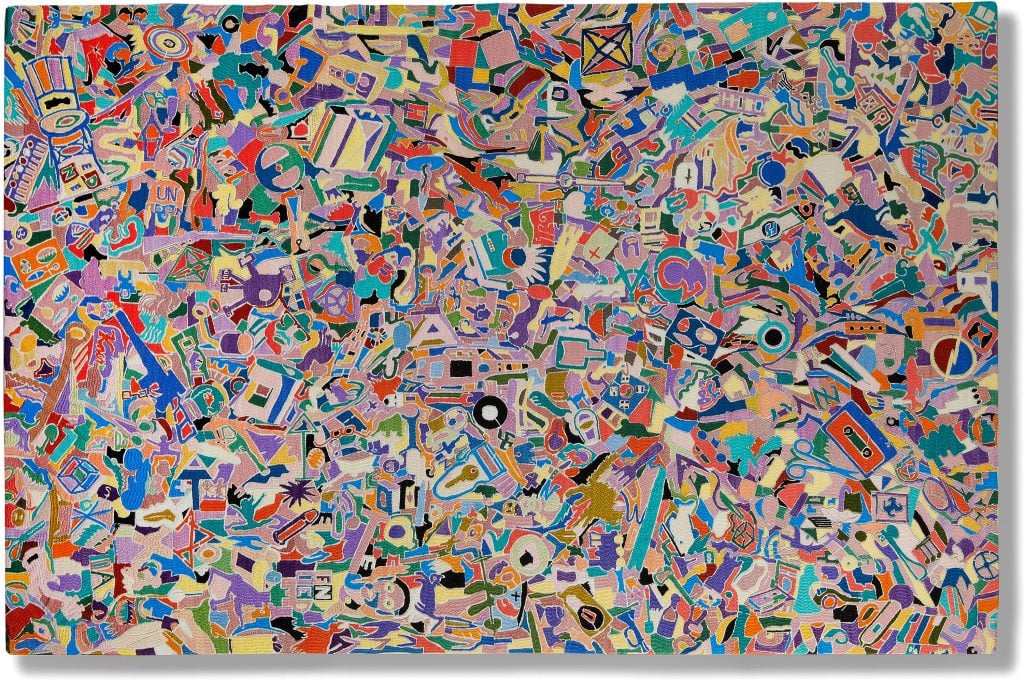
All eyes are on London right now, and not only because of Frieze and the assorted events that hitch a ride on the mega-fair. The city’s auction houses, too, are busily preparing for their premier sales of the season.
There is certainly no shortage of major works by major names—Basquiat, Richter, Bacon—to be had at the evening sales. Keen observers, however, will also be watching for other works to hit the block—works that may not light up the proverbial marquee, but whose stories are just as fascinating. Here, we take a look at five.
Alighiero Boetti, Tutto (1988–89)
Bonhams Post-War & Contemporary Art Evening Auction
October 12, 2023
In this extraordinary work of embroidery, Tutto (1988–89), the Italian conceptual artist Alighiero Boetti captured his signature balance of order and chaos, error and perfection, the individual and society—a kind of totality, or tutto. Hailing from a private collection in Europe, it’s the lead item in Bonhams’s contemporary sale on October 12.
The inscription “Peshawar” gives a clue as to its origin. In the 1970s, Boetti—once a member of the Arte Povera movement before dissociating himself—set up operations in Kabul, Afghanistan, where he hired local artisans to create tapestries and embroidered works out of his hotel room. The Soviet invasion of Afghanistan in 1979 forced Boetti and his artisans to relocate to Peshawar, Pakistan. Both his “Tutto” series and perhaps his best-known series, “Mappa” (world maps embroidered with flags for territories), were born out of these collaborations.
The “Tutto” embroideries are Boetti’s final works and a pinnacle of his artistic endeavors; they’re a part of the permanent collections of the Centre Georges Pompidou in Paris and the Museum für Moderne Kunst in Frankfurt. A “Tutto” work rarely comes up at auction, says Bonhams, making it highly prized by both collectors and institutions. This exquisite example, bearing the pastel hues of the 1980s, is likely to bring between £700,000 and £1 million ($860,000–$1.2 million).
Peter Doig, By a River (2004)
Sotheby’s The Now Evening Auction
October 12, 2023
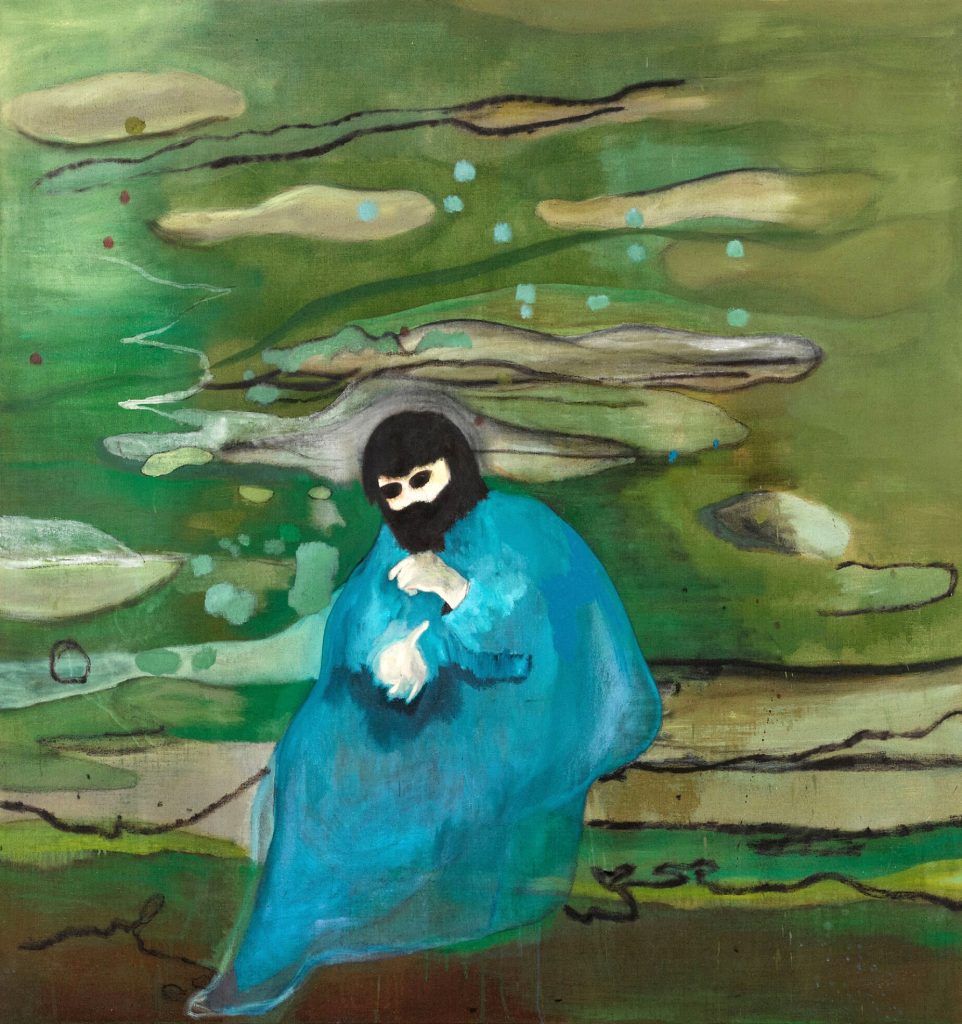
Peter Doig, By a River (2004). Courtesy of Sotheby’s.
Sotheby’s London is leading its ultra-contemporary sale, the first of a double-header on Thursday, with Peter Doig’s figurative stunner By a River (2004). The contemplative canvas could fetch a not-so-quiet £3 million to £4 million ($3.8 million–$5.1 million), the highest estimate of the sale, when the gavel falls on the 13th lot.
The work demonstrates the artist’s skill at interpreting art history through a contemporary prism. The vibrant blue robe and positioning of the lone figure allude to the early Netherlandish painter Geertgen tot Sint Jans’s introspective 15th-century painting St John the Baptist in the Wilderness, while the viridescent background recalls Edvard Munch’s uncanny Symbolist landscapes.
The work conveys personal reflection, too. Though the Scottish artist lived in Trinidad as a child in the early 1960s while his father worked in shipping, he felt conflicted about going back to the Caribbean island in 2002 to take part in an artist residency. It’s thought that this work, completed two years after the move, shows the artist’s ambivalence about the decision.
Doig returned to London in 2021, the same year his painting Swamped (1990) notched an auction record for the artist when it sold at Christie’s New York for nearly $40 million (fees included), having already yielded nearly $26 million in 2015. Earlier this year, the artist was the subject of a major exhibition of new and recent works at the Courtauld Gallery in London.
Ruth Asawa, Untitled (S.408) (1953–54)
Sotheby’s Contemporary Art Evening Auction
October 12, 2023
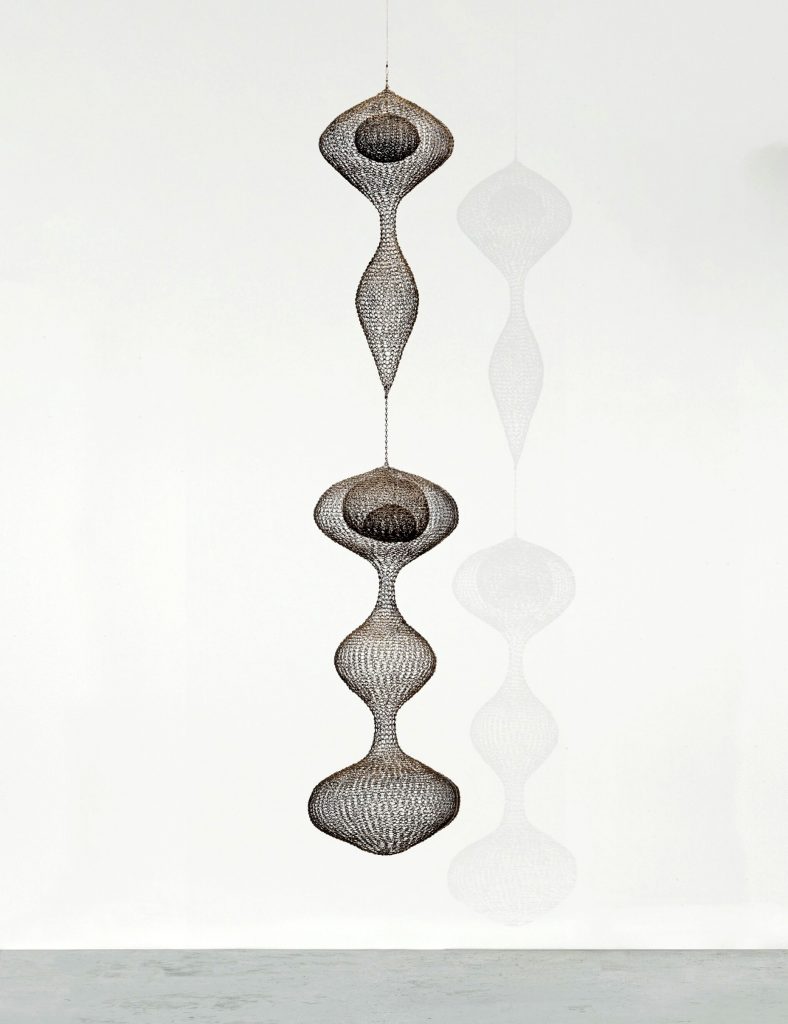
Ruth Asawa, Untitled (S.408, Hanging Five-Lobed, Two-part Form, with the Second and Third Lobes Attached by Chain and Interior Spheres in the First and Third Lobes) (1953–54). Courtesy of Sotheby’s.
A vibrant Gerhard Richter abstraction headlines Sotheby’s contemporary sale, but this meditative Ruth Asawa sculpture holds just as much fascination. The pensive piece was acquired directly from the American artist upon its completion in 1954 and not seen again—at least not in public—until its California-based owner consigned it to Bonhams New York in July 2020. Now a highlight of Sotheby’s contemporary sale, it’s expected to realize as much as £2 million ($2.5 million).
The bulbous beauty—whose full title is Untitled (S.408, Hanging Five-Lobed, Two-Part Form, with the Second and Third Lobes Attached by Chain and Interior Spheres in the First and Third Lobes)—is a stunning example of Asawa’s suspended looped-wire sculptures. Its overlapping layers of wire—mimicking water droplets, legume pods, and other organic shapes found in nature—explore notions of weightlessness, dimensionality, and the interplay of light and shadow. Each lobe smoothly segues into the next using a basket-crocheting technique the artist learned on a trip to Mexico in 1947.
Asawa perfected the craft in the late 1940s as a student of Black Mountain College in North Carolina—an experiment in democratic arts education lasting only 27 years. There, she studied under Bauhaus painter Josef Albers, abstract artist Ilya Bolotowsky, and the architect and futurist Buckminster Fuller, among others.
Upon graduation, she relocated to San Francisco for its progressivism, becoming closely associated with the Bay Area for the rest of her life. Her wire sculptures were shown at the San Francisco Museum of Modern Art in 1954, the same year this piece was made, and again in a 1960 solo show at the de Young Museum. She was instrumental in the creation of the city’s School of the Arts, which was renamed the Ruth Asawa San Francisco School of the Arts in 2010, three years before her death at age 87.
Paula Rego, Dancing Ostriches from Walt Disney’s ‘Fantasia’ (1995)
Christie’s 20th/21st Century Evening Auction
October 13, 2023
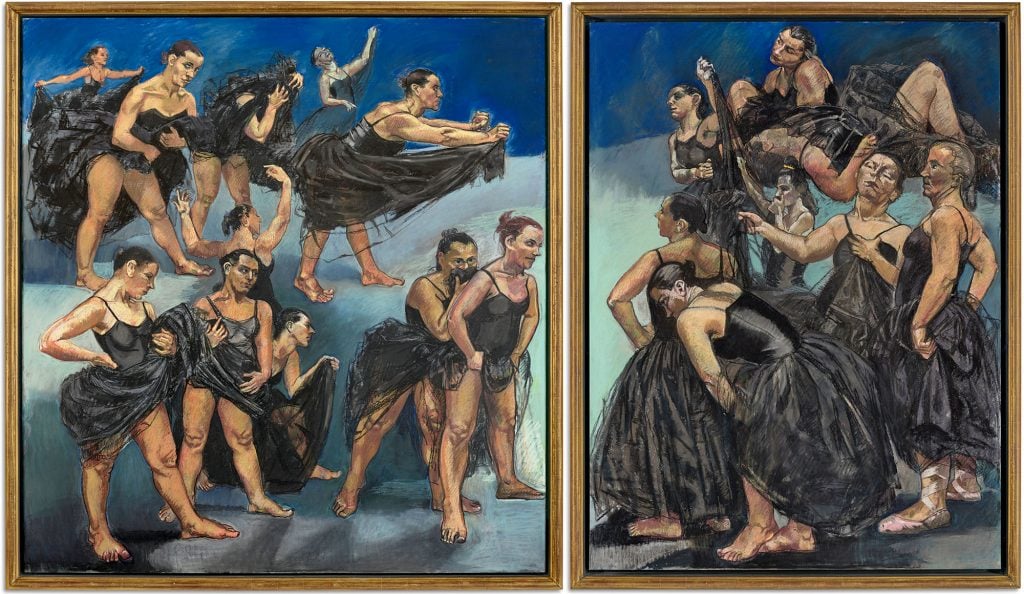
Paula Rego, Dancing Ostriches from Walt Disney’s ‘Fantasia’ (1995). Courtesy of Christie’s.
Offered for the first time at auction, Dancing Ostriches from Walt Disney’s ‘Fantasia’ (1995) is expected to garner between £2.2 million and £3.2 million ($2.7 million–$3.9 million) when it goes under the hammer at Christie’s London. It would be an auction record for the Portuguese-British artist, who died in 2022. To date, that record is held by The Cadet and His Sister (1988), which sold at Sotheby’s London in 2015 for £1.15 million.
The theatrical diptych is based on one of the film’s more memorable sequences, in which animated ostriches perform a ballet from Amilcare Ponchielli’s 1876 opera La Gioconda, flapping about in humorously cartoonish fashion. Rego alludes to the sequence in her dancers’ flightless postures and self-absorbed preening, yet the similarities end there. Where Disney’s avian dancers are feather-shedding caricatures, Rego turns them back into women (if rendered in pastel on paper). The work can be read as a challenge to the male gaze, pushing back against stereotypes and choreographed routines of youth, beauty, and femininity—a characteristic subversion of subject matter for the artist.
Rego has said that the piece—the central work in a series of five—stems from her enchantment with Walt Disney, whom she considered one of the greatest artists of the 20th century. During its making, she channeled fond memories of watching Fantasia, released in 1940, and other children’s classics as a young girl with her grandmother in Portugal. Her father operated the country’s first cinema, where watching Disney films on the big screen led to her lifelong interest in fairy tales and folklore.
Dancing Ostriches has been prominently exhibited all over the world since it was first displayed at London’s Hayward Gallery in 1996 to celebrate a centenary of British cinema. Shortly after that debut, it entered the Saatchi collection, from which the current owner acquired it. According to Christie’s, it has been requested for loan to the Kunstmuseum Basel in 2024–25.
Banksy, Forgive Us Our Trespassing (2011)
Phillips 20th Century & Contemporary Art Evening Auction
October 13, 2023
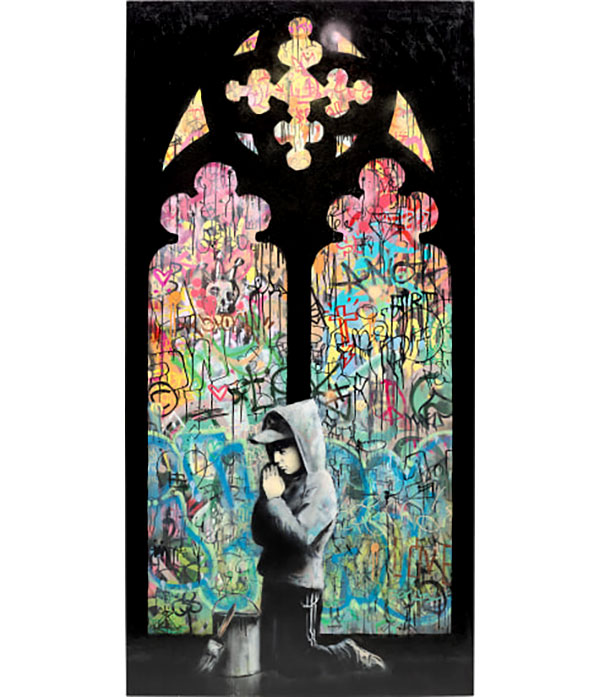
Banksy, Forgive Us Our Trespassing (2011). Courtesy of Phillips.
Banksy’s painting on plywood Forgive Us Our Trespassing, coming to auction for the first time, shows a boy in a hoodie and sneakers kneeling in prayer in front of a monumental stained-glass window that has been covered in graffiti. A paint bucket and paintbrush by his side indicates he is the one responsible for defacing the devotional structure with vandalistic scrawls. Squint and you can make out familiar tags like Jean-Michel Basquiat’s iconic skull and crown, a far cry from the biblical scenes typically observed in church windows.
The image of the kneeling boy, one of the anonymous artist’s most celebrated stencils, first appeared in 2010 in Salt Lake City, Utah. It was used that same year to promote the Oscar-nominated British documentary Exit Through the Gift Shop. In 2016, the work was exhibited at Palazzo Cipola in Rome, and it has been on long-term loan to the Moco Museum in Barcelona.
Forgive Us Our Trespassing is among a class of Banksy works evoking the innocence of youth. Images of this sort consistently achieve the highest auction prices, such as Love is in the Bin (2018), which self-shred during bidding, and Game Changer (2020)—each hovering around $25 million, according to the Artnet Price Database. This example is estimated to achieve £2.2 million–£2.8 million ($2.8 million–$3.6 million) at Phillips London, and comes with a certificate of authenticity issued by the Pest Control Office. Established in 2009 by the artist themself, the entity maintains that only it can authenticate a genuine Banksy.





